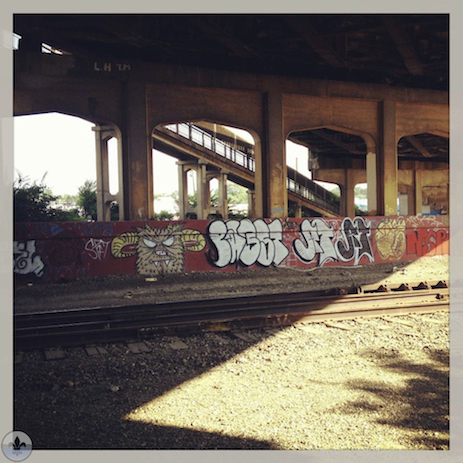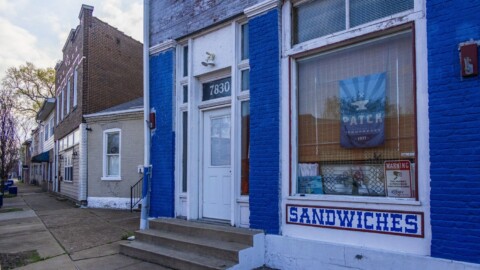photograph by Diane Cannon Piwowarczyk
An iconic “little Italy” neighborhood dating from the mid to late 1800’s, The Hill has remained remarkably unchanged over time. This is perhaps proof of the statement, “It ain’t over ’til it’s over.” spoken by The Hill’s most famous son, Yogi Berra.
photograph by Jason Gray
photograph by Ann Aurbach
photograph by Chris Naffziger
In point of fact, The Hill was not St. Louis’ first “little Italy”, as that distinction lies with the area surrounding the intersection of 7th and Carr in the Columbus Square neighborhood. This first Italian settlement featured squalid living conditions in tenement housing (mostly for factory workers or produce vendors, and their families), which slowly gave way to other nationalities, and eventually, to industry. However, The Hill is St. Louis’ first, truly Italian neighborhood, and it remains such, in population and character, unto present day.
photograph by Diane Cannon Piwowarczyk
photograph by Diane Cannon Piwowarczyk
The 19th century in St. Louis was characterized by the influx of immigrants from Europe. The last cultural group to arrive were the Italians, an emigration precipitated by poverty and oppression in their homeland. The Italians arrived mostly unable to speak English, and with little monetary means for investment. That said, hard work and cultural solidarity compensated well. The Fratellanza, an Italian interests society, was established in St. Louis in 1866 to represent the collective interest and provide services to the needy (it continues to be highly influential, on The Hill and beyond). This organization, combined with the fraternization and spiritual fulfillment brought about by the parish initiated by Father Cesare Spigardi, which serviced the entire region, helped the early immigrants to overcome the many challenges they faced.
photograph by Mandi Gray
photograph by Diane Cannon Piwowarczyk
photograph by Jeni Kulka
Italians began to populate the neighborhood of The Hill as early as 1880; they came for the jobs offered in the clay mines and for those with the brick manufacturers (both mostly north of what is now I-44 in what became known as the Cheltenham Industrial Complex). In 1890, two prominent railroads (the Frisco and Missouri-Pacific) ran lines through the area, connecting the mines and brick manufacturers to St. Louis and elsewhere. Industry prospered, as did the mostly Italian workforce. By 1900, a blueprint for what is recognizable today had coursed into action; The Hill featured a general store, many private residences, a saloon, etc., all while at a great distance from the City proper. Before 1920, St. Louis assisted the growing neighborhood by adding paved streets and other city services. As early as 1900, additional manufacturers, attracted by the significant workforce and ease of freight, built industrial facilities close to, or on, The Hill. These included the Quick Meal Stove Company (later Magic Chef), which remained a major employer for the area throughout much of the 20th century. The diversification of industry near The Hill proved prescient, since the Great Depression wrecked the profitability of brick and clay at Cheltenham. As most of the rest of the city felt the weight of economic crisis, this neighborhood of Italians in South City continued to prosper (by staying largely employed). This insularity continued through subsequent crises, including “White Flight”, and became a hallmark of the neighborhood, recognizable to this day.
photograph by Ann Aurbach
photograph by Diane Cannon Piwowarczyk
photograph by Mandi Gray
photograph by Mandi Gray
photograph by Jason Gray
photograph by Diane Cannon Piwowarczyk
By the end of the 1920’s, the neighborhood was already in full stride as a self-sustained community, full of goods, services, and entertainment available to residents and visitors alike. The addition of St. Ambrose Roman-Catholic Church in 1926 bolstered this premise, and the Church soon became a center of civic, educational and spiritual life for Hill denizens. The neighborhood was close-knit, and children played under the watchful and protective communal “eye”. Sports like soccer, baseball, and bocce ball (for which a club was formed in 1975) were practiced by the youth, and many important athletes emerged as a result (Joe Garagiola, Frank Borghi, Charley Colombo, Tom Lombardo, and the aforementioned, Yogi Berra, among them).
photograph via Missouri Department of Transportation’s website
photograph by Chris Naffziger
Interestingly, the greatest affront to the neighborhood, in its history, came not from economic or social turmoil, or natural calamity, but from the combined good intentions of City Hall, Jefferson City, and D.C. The Federal Aid Highway Act of 1956 approved for the construction of an interstate highway system whose purpose was to improve transportation and mobility throughout the country. Missouri was quick to begin; the very first stretch of concrete for the nationally lauded program was poured in St. Charles County (see pic above). As the program neared completion across the rural areas of the state, engineers, along with City and State officials, concluded that urban areas, especially those that had experienced some recent population declines, could be improved by removing existing buildings in order to create access via the highway. As the design for I-44 took shape, civic leaders on The Hill came to realize that the intention was to run the highway straight through their neighborhood. Understanding that this would cripple their community, local interest groups, including The Fratellanza, campaigned at City Hall to have the project re-routed further north. Although the efforts were successful at preventing the interstate from slicing through the central business district of The Hill, I-44 still pierced through the northern third of the neighborhood, causing over 100 homes to be razed. After the construction of the highway, civic groups again lobbied successfully for the construction of a pedestrian bridge to re-connect both areas of the old neighborhood. This impressive display of unified will against the seemingly insurmountable, joined forces of the City, State, and Federal Governments further testifies to the attachment of Hill residents to their neighborhood and each other.
Today, The Hill remains over 75% Italian. This is a testament to the availability of work and vibrancy of life achieved by early residents, which next generations sustained for over 100 years, and is ongoing. Compounding this, the common practice of handing homes down from parents to children, rather than placing them on the open market, has limited the diversification evident throughout much of the rest of the city. Additionally, this handing down approach has had a curious impact on the local architecture, where encrustations (when a building is added to or adapted for new use in a way that alters its original design) made to existing structures has produced an affect that can only be summarized as eclectic. A great variety of design and approaches are evident on any given block throughout the neighborhood, much like what we encountered in Ellendale (another neighborhood formed by manufacturing). Possibly though, what is most characteristic today about the neighborhood is its renowned collection of restaurants offering everything in Italian, from casual to formal. So rich is the history of the area’s restaurants that it truly deserves its own recollection; one that I recommend gaining firsthand from a local proprietor over a cold glass of Peroni and a plateful of pasta.
photograph by Diane Cannon Piwowarczyk
photograph by Jeni Kulka
photograph by Jason Gray
photograph by Mandi Gray
End point:
We met to converse and eat at Guido’s Pizzeria and Tapas which is a great mixture of all that dining on The Hill is known for: quality food, comfortable setting, a competitive beer and wine selection, and an attentive waitstaff. Additionally, we were able to make our reservations online, a quick and pain-free process.































[…] nationwide, and Missouri was quick to jump on board. Unlike some St. Louis neighborhoods, like The Hill, whose community groups helped to direct the course of the interstate through their areas, Mount […]